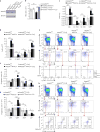Atad3a suppresses Pink1-dependent mitophagy to maintain homeostasis of hematopoietic progenitor cells
- PMID: 29242539
- PMCID: PMC5905408
- DOI: 10.1038/s41590-017-0002-1
Atad3a suppresses Pink1-dependent mitophagy to maintain homeostasis of hematopoietic progenitor cells
Abstract
Although deletion of certain autophagy-related genes has been associated with defects in hematopoiesis, it remains unclear whether hyperactivated mitophagy affects the maintenance and differentiation of hematopoietic stem cells (HSCs) and committed progenitor cells. Here we report that targeted deletion of the gene encoding the AAA+-ATPase Atad3a hyperactivated mitophagy in mouse hematopoietic cells. Affected mice showed reduced survival, severely decreased bone-marrow cellularity, erythroid anemia and B cell lymphopenia. Those phenotypes were associated with skewed differentiation of stem and progenitor cells and an enlarged HSC pool. Mechanistically, Atad3a interacted with the mitochondrial channel components Tom40 and Tim23 and served as a bridging factor to facilitate appropriate transportation and processing of the mitophagy protein Pink1. Loss of Atad3a caused accumulation of Pink1 and activated mitophagy. Notably, deletion of Pink1 in Atad3a-deficient mice significantly 'rescued' the mitophagy defect, which resulted in restoration of the progenitor and HSC pools. Our data indicate that Atad3a suppresses Pink1-dependent mitophagy and thereby serves a key role in hematopoietic homeostasis.
Conflict of interest statement
The authors declare no competing financial interests.
Figures








Comment in
-
Hyperactivated mitophagy in hematopoietic stem cells.Nat Immunol. 2018 Jan;19(1):2-3. doi: 10.1038/s41590-017-0008-8. Nat Immunol. 2018. PMID: 29242545 No abstract available.
References
-
- Sun MG, et al. Correlated three-dimensional light and electron microscopy reveals transformation of mitochondria during apoptosis. Nat Cell Biol. 2007;9:1057–1065. - PubMed
-
- Salminen A, Kaarniranta K, Hiltunen M, Kauppinen A. Krebs cycle dysfunction shapes epigenetic landscape of chromatin: novel insights into mitochondrial regulation of aging process. Cell Signal. 2014;26:1598–1603. - PubMed
MeSH terms
Substances
Grants and funding
LinkOut - more resources
Full Text Sources
Other Literature Sources
Medical
Molecular Biology Databases

